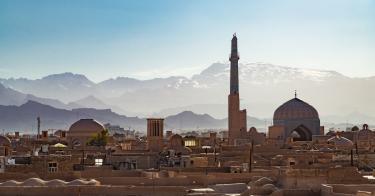Taking out Suleimani is only the latest in a long string of “last straw” events for those prone to call for America and the rest of the West to turn their backs on the vast expanse stretching from Mt Ararat to the deserts of North Africa.
That’s just not going to happen. It’s called the Middle East for a reason. It is in the middle of everything, and we can no more ignore this part of the world than the Nationals can focus on their hitting and forget pitching. When it comes to global geopolitics, the West has to play a complete game.
To be honest Hollywood, not to mention the rest of Western cinema, is of little help.
Reel after reel of celluloid is littered with silly tropes and endless caricatures of the peoples of this part of the world. Until recently, it was even highly unusual for an Arab character to be played by an Arab. Hollywood was more likely either to slather dark make-up on the likes of Lawrence Olivier (see Khartoum, 1966) or to pick someone “exotic-looking” (see the Indian actor Sabu as The Thief of Baghdad, 1940).
These films tell us very little about the lands of sand, blood and oil, but they tell us much about how we have seen them through our long inevitable history of difficult interactions.
7. The Wind and the Lion (1975)
Petroleum and the Suez Canal combined to transform the relationship of the Middle East and the West. Before that, the Middle East was just one big Disneyland adventure ride—zipping along from America’s first foray overseas (Tripoli) to Foreign Legionnaire-ing (Beau Geste and March or Die). The trope endured for decades, culminating in this romantic, action-laced spectacle of desert chieftain Sean Connery (the lion) facing-off against Brian Keith’s Teddy Roosevelt (the wind).
6. Lawrence of Arabia (1962)
No film marks the transformation of our appreciation from romantic land of mystery to hard-core power politics than this Oscar-winning portrayal where T.E Lawrence leads the House Saud against the Ottoman Empire during World War I. With an unforgettable musical score, peerless performances, stellar directing and a butt-numbing running time, it is a big movie that marks a big moment in history.
5. The Midnight Express (1978)
This brutal film presented the greater Middle East as an ugly place of trial and tribulation for Westerners. Here, an American arrested for drug smuggling faces a long and merciless stretch in a Turkish prison. In the halls of the Ankara Chamber of Commerce, this is surely the most hated movie ever made.
4. Argo (2012)
Following the Iranian Revolution, the American embassy staff were taken hostage. Despite that humiliation, America found it did not have the option of turning its back on this part of the world. The CIA came along with a shot of optimism. In this retelling of a true story, a veteran operative devises an audacious plan to sneak Americans out of the country.
3. Beirut (2018)
Other than Iran, the biggest bane of Western existence to arise from the Middle East has been terrorism. This gritty film has all the tropes from burned out streets to burned out secret agents. The movie ends with scenes from the 1983 bombings of the U.S. Embassy and the U.S. Marine Corps' barracks in Beirut—precursors to a long list of unspeakable terrorist acts and confrontation s punctuated by 9/11.
2. The Hurt Locker (2008)
When the problems of the modern world really started to catch up with the Middle East, President Jimmy Carter issued the “Carter Doctrine.” It anticipated that Americans would not have to fight wars in the region. That didn’t work out as planned. This fictional film follows an Army bomb disposal squad during some of the harrowing times following the second Iraq War.
1. Salmon Fishing in the Yemen (2011)
A fisheries expert and financial expert get involved in an improbable scheme with a Middle East sheikh. It’s a pleasant enough little film, but more importantly it’s a reminder that there is much more to this part of the world than terrorists and mad Iranian mullahs.
Over 400 million people live in the Greater Middle East. Sure, there are burned out streets, but there are also coffee shops and corner stores. There are extremist madrassas, but also world-class research universities. There are terrorists and entrepreneurs.
It is time that film and popular culture started giving us greater diversity of stories than tales of refugees and war zones. If we started appreciating that this is more than the birthplace of our problems, we might have a greater appreciation and greater vision on what the Middle East and West can do together.
This piece originally appeared in The National Interest




